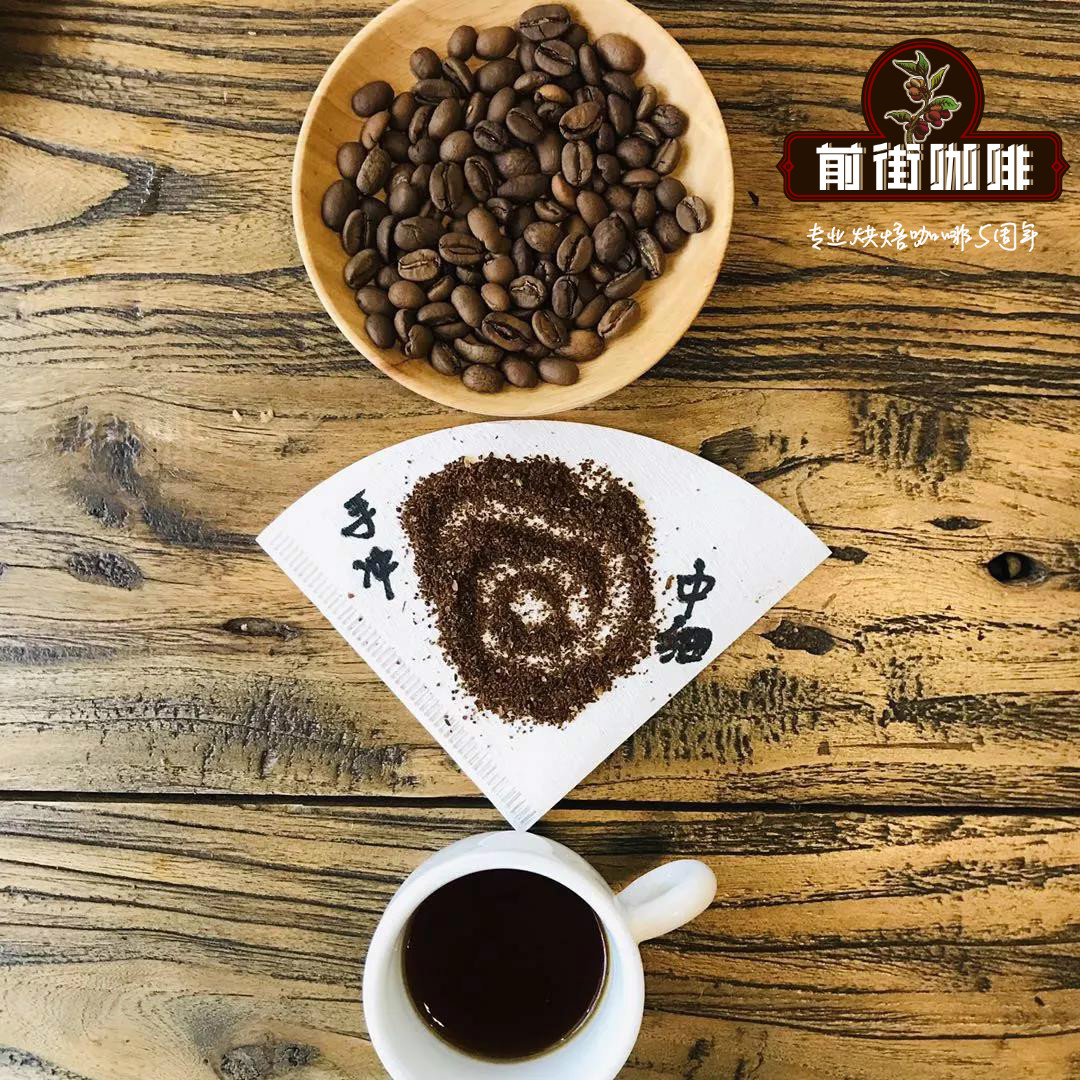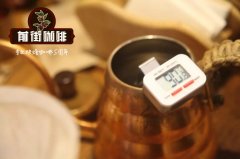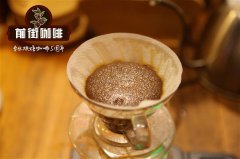What's wrong with your method of making coffee by hand? you'll understand it after reading this article.

Professional coffee knowledge exchange more coffee bean information please follow the coffee workshop (Wechat official account cafe_style)
"the most important key to making coffee by hand is not the brewing technique, but the grinding and the control of the water temperature."
Many people may not agree with this, but please take a patient look at the following instructions.
A long time ago, I thought about an interesting question: if you want to rate a near-perfect cup of hand-made coffee as 100, then the scores of all aspects of the conditioning process, such as grinding, water temperature, brewing techniques, etc., should be allocated in what proportion is more reasonable?
Unfortunately, this kind of question usually can only resort to feeling, and it is difficult to give a scientific and quantifiable answer. The answer after my own reflection is that grinding and water temperature add up to about 80 points, and the remaining 20 points can be allocated to brewing techniques. When I put this idea forward in my coffee club, it was accepted by the members (or embarrassed to refute it), because every member has experienced that as long as we master the thickness and evenness of the grinding and make sure that the water temperature in the hand pot is appropriate, even if the brewing technique is not very skilled, you can still make a cup of quite delicious coffee (perhaps not perfect). This proves that brewing techniques are not the most important key to hand-brewing coffee.
The argument of reducing the importance of brewing techniques is bound to cause controversy and even infuriate a large number of coffee workers, because it seems to be a negation of their profession, but this is not my intention. After all, you need to have a good understanding of coffee in order to deal with the details such as grinding and water temperature properly. I would like to emphasize that to complete a successful cup of hand-brewed coffee, you should first score the relatively easy 80 points, and then use beautiful tricks to push the brewing to perfection in the remaining 20 points.
So next, we should study carefully, account for 80 points of hand coffee, grinding and water temperature, what are the details that should be paid attention to.
First of all, the thickness of coffee particles.
For a hand filter cup using filter paper, the ideal grinding is about 500 to 600 microns, but it must be adjusted according to three key points:
1. According to the actual taste
If the coffee is bitter and astringent and the tongue feels "dry", it usually means that the coffee is ground too fine and the extraction is a little too much; on the contrary, if the coffee is light or feels a little "watery", it is probably too coarse and not enough to extract.
2. According to the amount of powder
The suitable thickness for brewing one or two cups of coffee may be too fine if it is used to brew a large pot (5, 6 cups or more), because increasing the number of cups will increase the amount of coffee powder, increase the thickness of the powder, and increase the resistance of water to pass through. as a result, the contact time between water and coffee powder will be prolonged. So when the amount of bubbling increases, the size of the grinding should be slightly enlarged.
3. According to the freshness
Beans that are too fresh should be slightly thicker to grind, while beans with poor freshness should be ground finer. This is because when coffee particles come into contact with hot water, they will release internal gas and produce foam; most of the foam will float on the liquid surface, forming "coffee flowers", but some of them will be mixed inside the coffee mud bed, increasing the hindrance to the passage of water, thus prolonging the contact time between water and coffee powder. The more fresh the beans are and the more bubbles there are, the more obvious the blocking phenomenon will be. Therefore, it is a common practice for experts to adjust the grinding thickness appropriately according to the freshness of coffee.
However, how to set the criteria for determining the freshness of coffee? Here, I would like to provide my own practice for readers' reference. I usually only classify beans no more than 3 days after roasting as "extremely fresh", beans more than 7 or 8 days after roasting as "less fresh", and those in between as "normal". If the "normal" bean chooses the grinding scale of "4", then in the other two cases, one chooses "4.5" and the other chooses "3.5".
Secondly, the uniformity of grinding.
In an ideal grinding, it is best to grind each coffee particle of the same size and shape, so that the uniformity can be best when brewing. But in fact, no matter what kind of grinder you use, you can't do this. No matter how high-end the grinder is, the coffee powder will inevitably contain a little thicker particles and too fine powder, in which the coarse particles are relatively easy to flash, and the dust is absolutely difficult to avoid. If the amount of these too coarse or too fine particles is small, the problem is not serious, and if there is more, there will be the phenomenon of "some particles are not completely extracted, but there is already some excessive dust extraction", so it is very important to make the coffee particles as big as possible.
Some people argue that uneven grinding can bring more "layering" to coffee, but this is a wrong view. Because the size and shape of coffee particles can not be the same, so the dissolution rate of soluble matter can not be the same, in other words, uneven layering already exists. In addition, almost all professionals agree that the more uniform the grinding, the better the brewing effect.
But to do this, there are probably only two feasible ways, one is to buy a relatively high-end grinding machine to improve grinding uniformity, and the other is to purchase a powder sieve as an auxiliary. I am more in favor of the first of these two methods, because it takes an extra expense to buy a powder sieve, and the aroma of fresh coffee is more or less sacrificed in the process of sieving, while buying a high-end grinder, but only once the heartache (and may have to hide the true price to the other half).
Finally, the temperature of the water when brewing.
This may be the most divergent point of opinion. Many people, including many in the industry, prefer to use hot water at a lower temperature of about 85-90 degrees Celsius to make coffee, which is a far cry from the 92-96 degrees recommended by foreign experts. I have repeatedly tested the brewing effect of different temperatures and concluded that 92-96 degrees is indeed ideal. In addition, take a look at the 2016 World Cup Cooking Competition (WBrC) in Dublin, recorded by Sprudge Media Network, how many degrees of water each of the six finalists used to brew:
First place, Japan, Tetsu Kasuya, unknown
Second place, Finland, Mikaela Wallgren,96 degree
Third place, Taiwan, Wang ce, 92 degrees
Fourth place, Hong Kong, Benny Wong,94 degree
Fifth, the United States, Todd Goldsworthy,95 degree
Sixth place, Norway, Odd-Steinar T ø llefsen,90 degree.
Apart from being unable to find out the water temperature data of the Japanese players, I wonder if the Norwegian players have been underscored by the referee because of the use of 90 degrees water.
There is something to be added about the temperature of the water.
How to control the temperature range from 92to 96? The principles are roughly as follows: if the water temperature is on the high side, the extraction rate will increase, regardless of the sour taste, bitterness, astringency and concentration; if the water temperature is low, the extraction rate will decrease, but in terms of ratio, the bitterness and astringency will decrease more, and the sour taste is easier to highlight.
Although 92-96 degrees is accepted by most people, eating is a very personal behavior. If you think 85-90 degrees is your favorite temperature, you don't have to listen to what others say, just do it the way you like it, but I suggest that occasionally try hot water around 93 degrees for hand flushing, which may change your mind.
As mentioned earlier, grinding and water temperature account for 80 out of 100 points for hand-brewed coffee, compared with 20 points for brewing, which is a bit like a side effect. Having said that, you shouldn't give up the remaining 20 points in pursuit of perfection, but that goes beyond this article and is the topic of the next article.
Related recommendation: is hand-made coffee really good? Why does coffee smell better than it tastes?
Important Notice :
前街咖啡 FrontStreet Coffee has moved to new addredd:
FrontStreet Coffee Address: 315,Donghua East Road,GuangZhou
Tel:020 38364473
- Prev

Is it bad to make coffee by hand? You did it in the wrong way!
Professional coffee knowledge exchange more coffee bean information Please follow the coffee workshop (Wechat official account cafe_style) some time ago the editor encountered a barista's question: why is my coffee always underextracted? No flavor? Then I sent a small video to watch the process. As a result, I almost fainted and used a V60 filter cup. Instead of steaming, I injected water directly to the end and watched the water.
- Next

Say the important thing again: coffee must be steamed by hand.
Professional coffee knowledge exchange more coffee bean information Please follow the coffee workshop (Wechat official account cafe_style) I believe that many people, including editors, know from the moment they come into contact with coffee that an essential step in making coffee is: steaming! For hand-brewed coffee, the steaming process is crucial. Steaming is the starting point of the process of hand flushing.
Related
- Beginners will see the "Coffee pull flower" guide!
- What is the difference between ice blog purified milk and ordinary milk coffee?
- Why is the Philippines the largest producer of crops in Liberia?
- For coffee extraction, should the fine powder be retained?
- How does extracted espresso fill pressed powder? How much strength does it take to press the powder?
- How to make jasmine cold extract coffee? Is the jasmine + latte good?
- Will this little toy really make the coffee taste better? How does Lily Drip affect coffee extraction?
- Will the action of slapping the filter cup also affect coffee extraction?
- What's the difference between powder-to-water ratio and powder-to-liquid ratio?
- What is the Ethiopian local species? What does it have to do with Heirloom native species?

